Hospital Ship
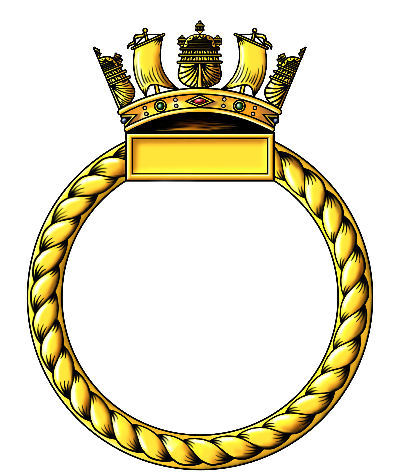
No badge issued for this vessel
Battle Honours
None
Specifications
Builder: SA Ansaldo, La Spezia, Italy
Displacement: 7,432 Gross tons
Length: 427 ft 1 in
Beam: 52 ft 6 in
Draught: 24 ft 6in
Propulsion: 6 Ansaldo Sampierdarena turbines, double reduction geared, driving two propellers
Speed: 14? Knots
Armament: None
Crew complement: Unknown
Commanding Officers
Captain William J. Merchant MN
Senior Medical Officer
Surg. Captain A. de B. Joyce, MB, ChB, DOMS Mayy 1945
Surg. Captain D. M. Beaton OBE, LRCP & S February 1947
Related items
None
Reminiscences
None
Gallery
None
H.M.H.S. EMPIRE CLYDE
Read aloud
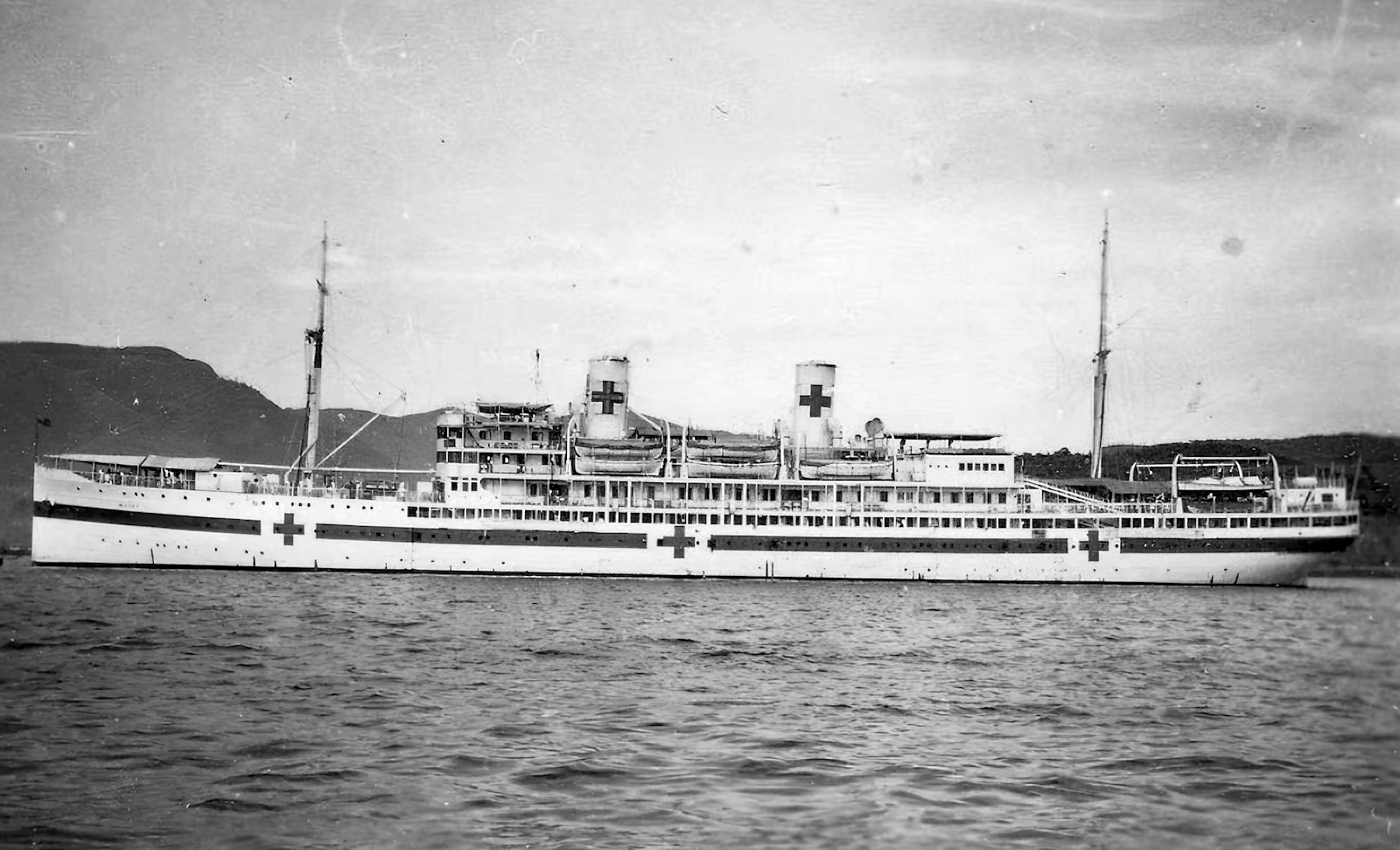
HMHS EMPIRE CLYDE
Early history
Originally a 7,432 grt cargo/passenger liner ordered from SA Ansaldo, La Spezia, Italy in 1919 for the Società di Navigazione Transatlantica Italiana shipping company. Laid down as yard number 192 in 1924 she was launched on December 28th 1924 and named LEONARDO DA VINCI. She left Naples for the maiden voyage on May 24th 1925, bound for New York via Palermo and Boston; this was followed by two further crossings before she switch to the South America route in November.
Due to financial problems and some shipping companies going bankrupt the Società di Navigazione Transatlantica Italiana line was purchased by Credito Italiano on December 22nd1925 they in turn formed a new company, the Compagnia Italiana Transatlantica (CITRA) but business was still slow and the LEONARDO DA VINCI was laid up in1926 until the end of 1929. She sailed from Genoa on December 11th 1929 carrying an exhibition comprising one thousand Italian works of art for display in Burlington House in Piccadilly, London, arriving at the East India Dock in London on the 20th. On completion of the exhibition the art works were returned to Italy onboard the LEONARDO DA VINCI, sailing from London on April 12th 1930. After a period of charters, over the next three years the LEONARDO DA VINCI was transferred to the Tirrenia Flotte Riunite Florio-CITRA In 1934.
In March 1935 the LEONARDO DA VINCI was used as a troop transport in preparation for the Ethiopian War. In February 1936 the ship transported the hierarchs Galeazzo Ciano , Roberto Farinacci and Achille Starace to East Africa. Later, during the same month she transported the military attachés of Japan, the United States, Austria, Albania and Hungary from Eritrea to Mogadishu. In 1936 the ship was seriously damaged by a violent fire, requiring reconstruction work which increased hewr gross tonnage to 7515 GRT. On completion of the work she was again used as a troop transport and to carry the Viceroy of Ethiopia and his entourage. Later in 1936 she was employed again for the transport of Italian works of art to the United States and the United Kingdom.
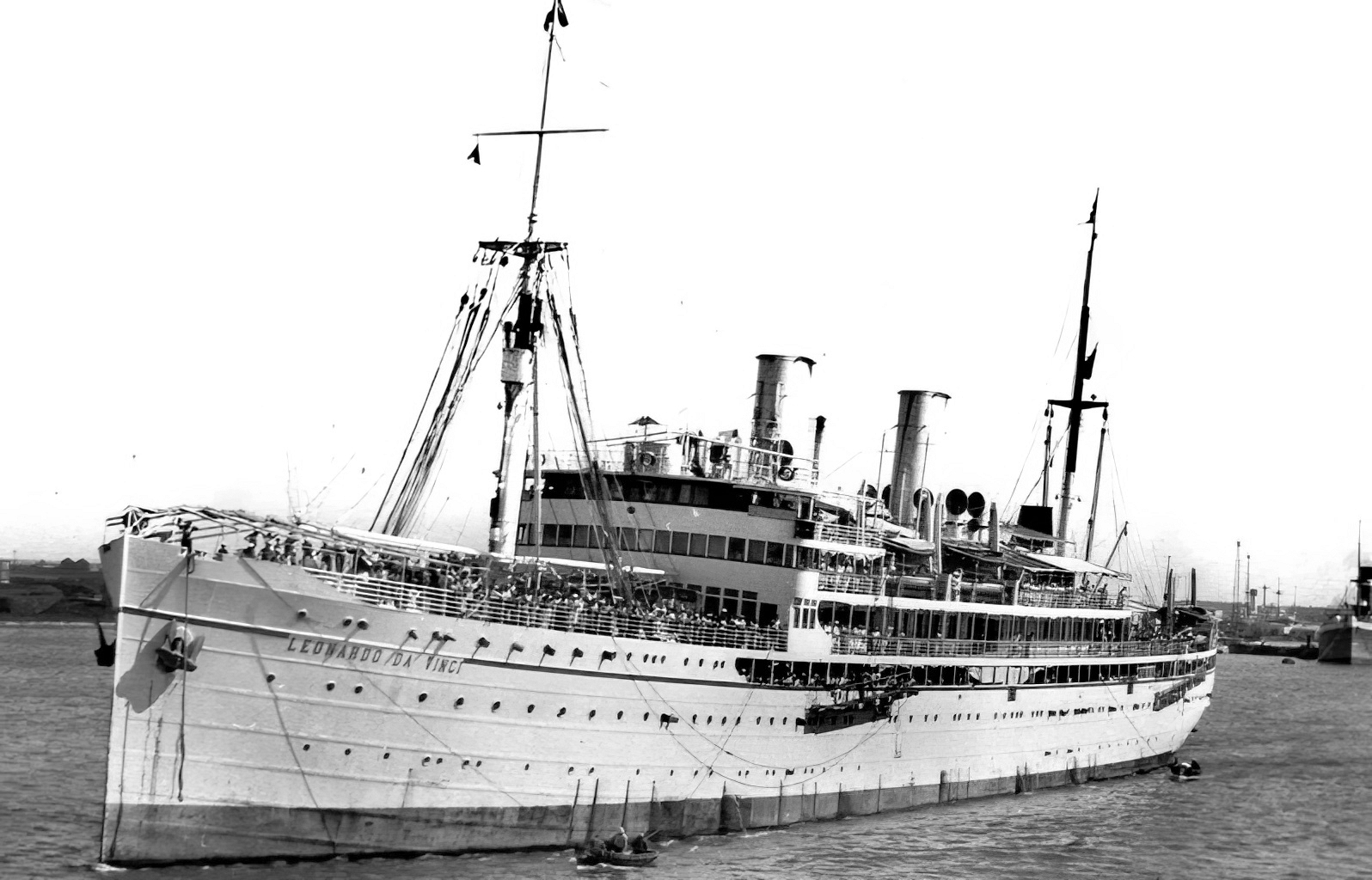
The MV LEONARDO DA VINCI
In December 1936 there was another reorganization of the Italian shipping companies and the LEONARDO DA VINCI was purchased in 1937 by the Società Anonima di Navigazione Lloyd Triestino, based in Trieste. Upon Italy’s entry into World War II the LEONARDO DA VINCI, on June 10, 1940, the LEONARDO DA VINCI took refuge in Kismayo, in the Italian colony of Somalia, where she was stationed inactive for about eight months being used as a freshwater producing plant for the Italian garrison there.
Captured by the British and operated by the Ministry of War Transport as a war prize
when the Italian resistance crumpled a number of Italian ships made an effort to escape; on 10th/11th February 1941 the LEONARDO DA VINCI and the mixed steamers ADRIA and SOMALIA, the tanker PENSILVANIA and the cargo steamers SAVOIA, ERMINIA MAZZELLA, DUCA DEGLI ABRUZZI and MANON, sailed from Kisimaio in an attempt to take shelter at Diego Suarez however shortly after reaching the open sea the ships were intercepted by a force of British cruisers. Three of the Italian ships were scuttled on approach, the ADRIA, SAVOIA, ERMINIA MAZZELLA, MANON, and LEONARDO DA VINCI were captured ordered back to port but on the way the Italian crew made a half-hearted effort to sabotage her by shutting the oil supply off from the turbines, damaging them extensively. She was towed to Mombasa were the Italian crew was taken off to be interned in prison camps in Kenya and South Africa. Engineers were sent out to make temporary repairs, the damage was severe and the ship was under repair until September 30th.
She was passed to the Ministry of War Transport as a war prize. Her port of registry was changed to Mombasa, Kenya, under the British Flag. She was placed under the management of the City Line. Once sera worthy the LEONARDO DA VINCI sailed from Mombasa on October 7th for Bombay, arriving on the 22nd to await a decision about her future use; she underwent further repair work and fitting out as a transport vessel. It was decided to send her to Hong Kong 'for repairs to her engines but this was abandoned when the Japanese entered the war and it was then decided that the necessary repairs must be effected in the United States.
Under the command of Captain William J. Merchant, the LEONARDO DA VINCI sailed unescorted in waters where both Japanese and German submarines were operating, for Durban on September 21st. Progress was slow, she had several stops at sea due 1o boiler trouble before arriving on October12th. At Durban she underwent further work, which lasted until November 23rd when she sailed for Cape Town, arriving on the 27th. At some stage she was armed with a single stern mounted QF 4 inch gun and 3 single Orliken 20 mm cannon, one aft, one amidships, and one forward.
She sailed from Cape Town for Pernambuco, Brazil on December 3rd, where she arrived on the 19th. She departed on New Year’s Eve 1942, for Trinidad, arriving on January 10th, 1943. She spent two weeks in Trinidad before sailing as part of convoy TAG 38 on January 24th, arriving off at Guantanamo Bay on the 29th where she joined convoy GN 38 for New York, arriving on February 4th. Here she underwent further repair work which was completed on the 15th.
Leaving New York on February 17th the ship arrived at Hampton Roads the next day, and at Newport News Navy yard on the 9th. She now underwent a major repair program to finally fix the damage to her engines done by her Italian crew, on entering the yard her propulsion system was completely removed. She departed Newport News on March 5th under tow to Baltimore, arriving on the 7th. In her civilian career the LEONARDO DA VINCI had been outfitted for operations in tropical climates, so travel in in the cold winter weather of the Atlantic meant her crew suffered considerable hardships. The weather on the trip along the North American coast was so cold that her spirit compasses froze adding an extra hazard to navigation on a voyage that had to be made close to the shore all the way because of the submarine menace. She was to remain in dockyard hands for six months for the installation of new engines and her management was transferred to the City Line.
On August 27, 1943, the work completed, LEONARDO DA VINCI left Baltimore for New York, where she arrived the following day. Carrying a general cargo and joined convoy HX 255 comprising of 56 merchant ships and 19 escorts which departed from New York City on September 2nd1943 bound for the UK. She arrived at Glasgow on September 15th.

The fully repaired and armed MoWT transport vessel LEONARDO DA VINCI off New York on August 28th 1943
Requisitioned for conversion to a military hospital ship
Now in the UK it was decided to convert her into a military hospital ship for the use of the British Army. The conversion Work was to be carried out by a dockyard on the Clyde and included removal of her armaments and the creation of spaces for use as wards, an operating theatre, X-Ray room, a dispensary and additional toilet and washing areas and accommodations for the small female contingent. On completion she could accommodate 411 patients, including 25 officers.
In addition to master and Merchant Navy crew, she carried a medical staff consisting of nine medical officers, seven nursing sisters under a matron, and male medical orderlies October 7th she was renamed Hospital Ship No. 54 "EMPIRE CLYDE" however she was not ready for active duty until April 1944. She was now painted overall white with a green line round the hull with large red crosses painted amidships and on her funnels. At night she sailed with all her lights on illuminating the Red Crosses to identify her as a non-combatant and therefore protected by the Geneva Convention.
She was to be almost exclusively operated in the Hospitals Carrier role making round trips to Mediterranean ports collecting patients for return to UK hospitals. She sailed on her first voyage on April 4th leaving the Clyde bound for the Mediterranean, She arrived at Algiers on the 11th, presumably to embark invalids, before sailing on the 13th for Naples, arriving there on the 15th to embark more patients. ON the 16th she sailed to return to the UK, arriving at Avonmouth on the 25th.

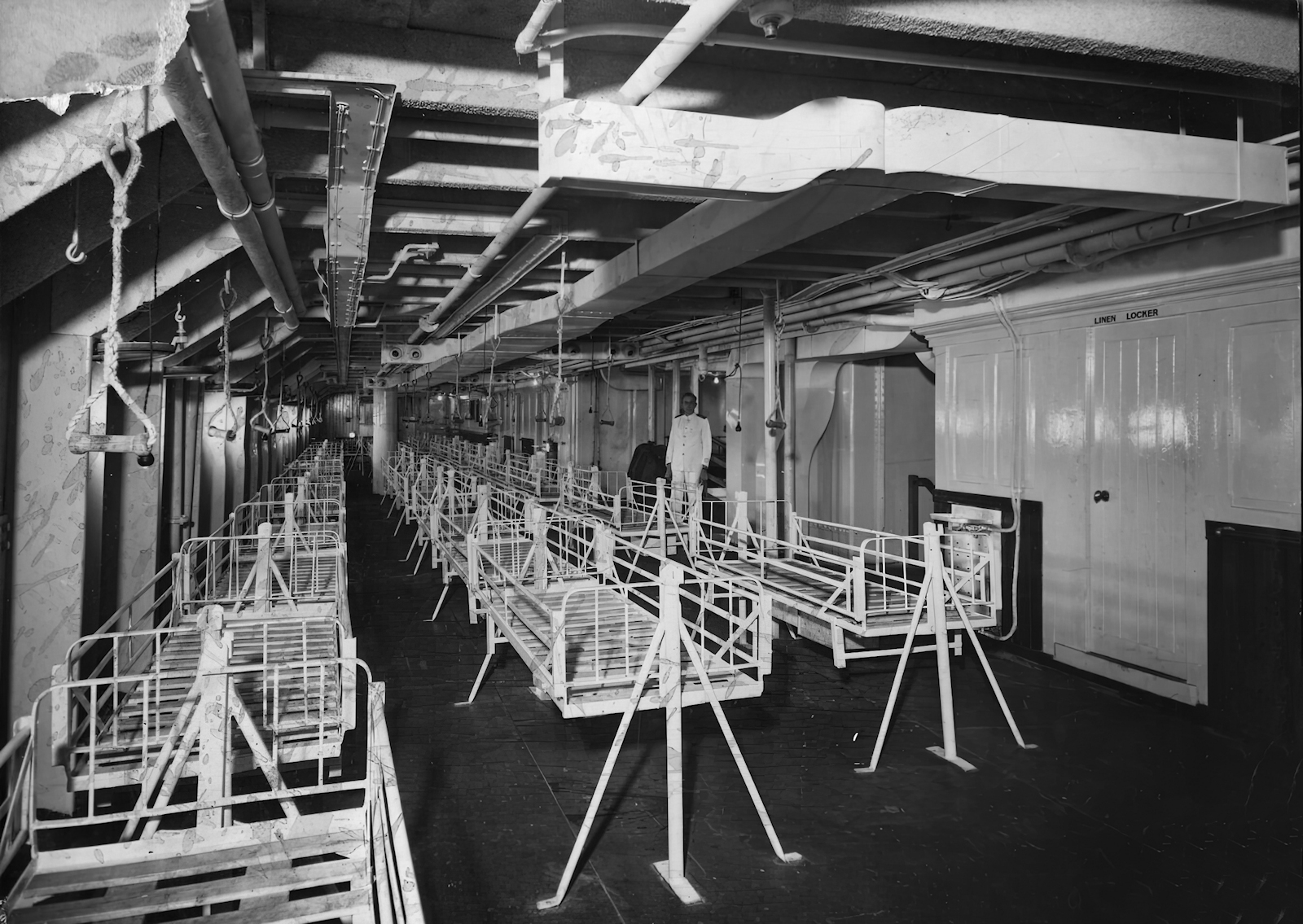
Examples of passenger decks converted into Hospital Wards. Left fixed single and double cots, right: gimbaled cots able to keep patients on an even keel in conditions were the ship would roll. Items P1892_05 & P1892_06 from atom.drisa.co.za
After a short turnaround she sailed to repeat the voyage leaving Avonmouth on April 30th. This time she called at Gibraltar on May 5th before arriving at Naples on the 8th. She sailed the following day bound for Liverpool, arriving on May 17th to disembark her patients before arriving Glasgow on the 20th for three days of Dockyard work to be carried out.
She sailed for Naples via Gibraltar on May 24th, arriving on June 1st. On the 2nd she sailed for Glasgow arriving on June 10th. Two days later she entered a dockyard for repairs, the work taking two weeks. She appears to have remained on the Clyde until October before resuming its roundtrip voyages to Naples, siling on October 9th, arriving at Gibraltar on the 25th and sailing on November 1st calling at Bona on the 3rd before arriving at Naples on the 5th. On completion of embarking invalids for passage she departed Naples on the 7th bound for Liverpool, arriving there on the 15th. At Liverpool she underwent repairs beginning on the 16th. She sailed for Naples again on November 19th. She arrived at Naples on the 27th, sailing for Taranto the next day, arriving on the 29th. She sailed to return to the UK the next day, arriving at Falmouth December 9th. Before continuing onto Southampton on the 10th. She sailed for Naples again on December 16th, arriving there on Christmas Eve. She sailed for Algiers on the 26th, arriving on the28th, sailing for the Clyde the same day. She arrived on the Clyde on January 3rd 1945.
She sailed for her seventh voyage to the Mediterranean on January 6th, this time extending her voyage eastwards to collect patients from ports in Sicily and Greece. She called at Algiers on the 12th before sailing for Sicily calling at Palermo on the 14th and continuing on to Catania before heading north to Taranto, arriving on the 16th. She remained at Taranto until February 2nd when she sailed for Thessaloniki, Greece arriving on the 5th. Two days later she sailed for Piraeus on the 8th calling there on the 10th before sailing o return to Taranto where she called on the 12th then Catania before arriving at Naples on the 16th. After embarking more patients EMPIRE CLYDE departed Naples oon Febraury19th to return to the Clyde where she arrived on the 26th.
This was her last voyage as an Army Hospital Ship, she was earmarked for transfer to the Admiralty for operations with the British pacific Fleet (BPF).
Transferred to Admiralty control and allocated for service with the British Pacific Fleet
On March 3rd Hospital Ship No. 54 entered a Clyde Dockyard to undergo refit and repairs in preparation for her transfer to the Admiralty; this work would not be completed until June 30th. Her naval medical staff embarked in late May, this comprised of 8 medical officers, a Dental surgeon, a Chaplin, a Warrant Ward master, a Matron and 6 reserve nursing Sisters with 57 sick Berth Attendants under the command of Surg. Captain A. de B. Joyce, MB, ChB, DOMS, Senior medial Officer, matron Miss J. M. Woodgate was in charge of the nursing staff. All had been appointed by May 25th but only 25% had been embarked by the time she left the UK, and would not be brought up to full complement until she reached Australia .
EMPIRE CLYDE did not sail for the Pacific until July 27th 1945, calling at Gibraltar on August 1st and arriving at Taranto on the 4t h. Here she was to embark 55 patients, including five stretcher cases although there was accommodation for considerably more than that number. About 200 protected personnel, mainly of the New Zealand Medical Corps, also travelled on the ship, including several New Zealand nursing sisters accompanying the troops. Sailing on the 6th she proceeded to Port Said to transit the Canal on the 10th. She sailed from Port Tewfik on the 11th for Colombo and had reached Aden when the news of the capitulation of Japan was received. Aden being no place at all to celebrate in, they stayed aboard, and the passengers and crew celebrated the occasion with an extra special dinner. The ship arrived at Colombo on the 23rrd. After taking on fuel and stores she sailed for Fremantle on the 25th, calling there on September 6th to disembark her Australian charges. After embarking the remainder of her medical staff she sailed on the 7th to proceed to Wellington where she arrived on the 18th. Once docked she disembarked the New Zealand personnel from the Mediterranean only 55 of them were patients.
After eleven days at Wellington EMPIRE CLYDE sailed to join the British Pacific Fleet at Manus in the Admiralty Islands, putting to sea on the 28th. She arrived at Manus on October 9th, sailing for Shanghai the following day. Shanghai had been liberated by BPF task Group 111.3 ion September 12th when RAPWI (Recovery of Allied Prisoners of War and Internees) teams for the evacuation of POWs were landed from the Light Fleet Carrier HMS COLOSSUS. The Landing Ships Infantry (L) GLENEARN had evacuated approximately 400 internees fit to travel on October 2nd for Hong Kong, EMPIRE CLYDE was to embark those who remained receiving medical care. She arrived at Shanghai on October 19th and embarked patients for passage to Hong Kong, sailing on the 24th and arriving at the colony on the 27th. On reaching Hong Kong she assumed the duty of Base Hospital Ship.
On May 8th 1946 EMPIRE CLYDE sailed for the Chinese island of Hainan to embark 576 Chinese nationals, former prisoners of the Japanese during the war and employed as forced laborers. Of these 65 were stretcher cases and 511 sick. She sailed from Hainan on May 22nd arriving back at Hong Kong on the 28thl. She remained at Hong Kong until July 5th 1946 when she sailed for Kure, Japan arriving thee on the 9th to embark patients, and sailed for Singapore on the 11th. On arrival on July 21st she discharged her patients to hospitals ashore in preparation for entering a dockyard for repairs beginning on the 26th. On completion of the work she sailed a round trip voyage to Hong Kong on August 30th, arriving and sailing on September 5th and arriving back at Singapore on the 11th. She now began duty as the Base Hospital Ship at Singapore; she made another round trip voyage to Hong Kong departing on November 1st, arriving there on the 6th and sailing to return on the 16th arriving back at Singapore on the 21st. She was now released from duty at Singapore and sailed to return to the UK on November 22nd via Australia and Ceylon.
Return to the UK
EMPIRE CLYDE arrived at Sydney on December 9th where she embarked patients for passage; these were the last British service personnel to leave Australasia, having been hospitalized until suitable transport could be arranged for their repatriation. These included 200 Italian POWs, 40 of them mental cases, for passage home to Naples. She sailed from Sydney on December 11th for Melbournewhere she arrived on the 16th. Here she embarked a number of Greek merchant navy repatriates and some RAF and Royal Navy stretcher cases before sailing for Fremantle on the 17th.
She called at Fremantle on the 23rd where Afurther10 sick Italian prisoners were embarked at Victoria Quay; later that day members of the Red Cross hospital visiting unit came aboard to provide such extras as Christmas puddings, jellies, fruit salad, flowers and decorations for the wards before she sailed for Trincomalee. She called at Trincomalee on January 3rd 1947 and arrived at Colombo on the 4th and sailed for the Suez Canal on the 5th. She arrived at Port Tewfik on the 16th and sailed to transit the Canal on the 17th, arriving at Port Said later that day. Arriving at Naples on January 22nd she disembarked all of her Italian patients before continuing on to Malta on the 23rd. On arrival at Malta she assumed the duty of as base hospital ship and her medical personnel, some of whom had been on board since May 1945, were relieved and new staff appointed, Surg. Captain D. M. Beaton OBE, LRCP & S arrived to assume the post of Senior Medical Officer on February 22nd 1947.
Purchased by the Admiralty March 1947
On March 31st the EMPIRE CLYDE was released from the custody to the Ministry of Transport and by the Admiralty; at this time she was the only Royal Nava Hospital Ship still in commission. Shortly after she entered a Maltese Dockyard for a 4 month reconstruction and upgrade to her medical facilities; during her short war-time career she had operated as Hospital Carrie with minimal facilities for conducting surgical procedures or treating serious diseases, the refit brought her up to full Hospital Ship status. On January 1st 1948 she was reassignment to the Royal Fleet Auxiliary for crewing and management as HMHS EMPIRE CLYDE. On January 26th she was renamed HMHS. MAINE (IV), contusing the tradition that all RFA Hospital Ships were named ‘MAINE’.
In her new configuration she was fitted out to do no more than meet the normal peace-time needs of the Royal Navy, namely, to accompany a fleet on cruises. As a result she was not ideally placed to begin operations in the Far East when the Korean War broke out in 1950, primarily the lack of air-conditioning or adequate ventilation. Air-conditioning had only been fitted in the operating theatre, in one of the wards and in some of the accommodation. The remainder of the ship had adequate ventilation, except on E deck, which was fitted with the punka louvre type ventilation system as the wards on this deck were not intended for patients confined to bed.
During the early stages of hostilities in Korea, MAINE was the only hospital ship in the area , she came under the control of the United Nations and she was continuously employed in transporting wounded, mainly American, from Korea to Japan with periodic voyages to Hong Kong to refit and restock medical supplies. After six years of operation with the Royal Fleet Auxiliary it was announced in March 1954 that she was to be disposed of; she was sold to a Hong Kong shipbreakers for scrapping on May 25th 1954.
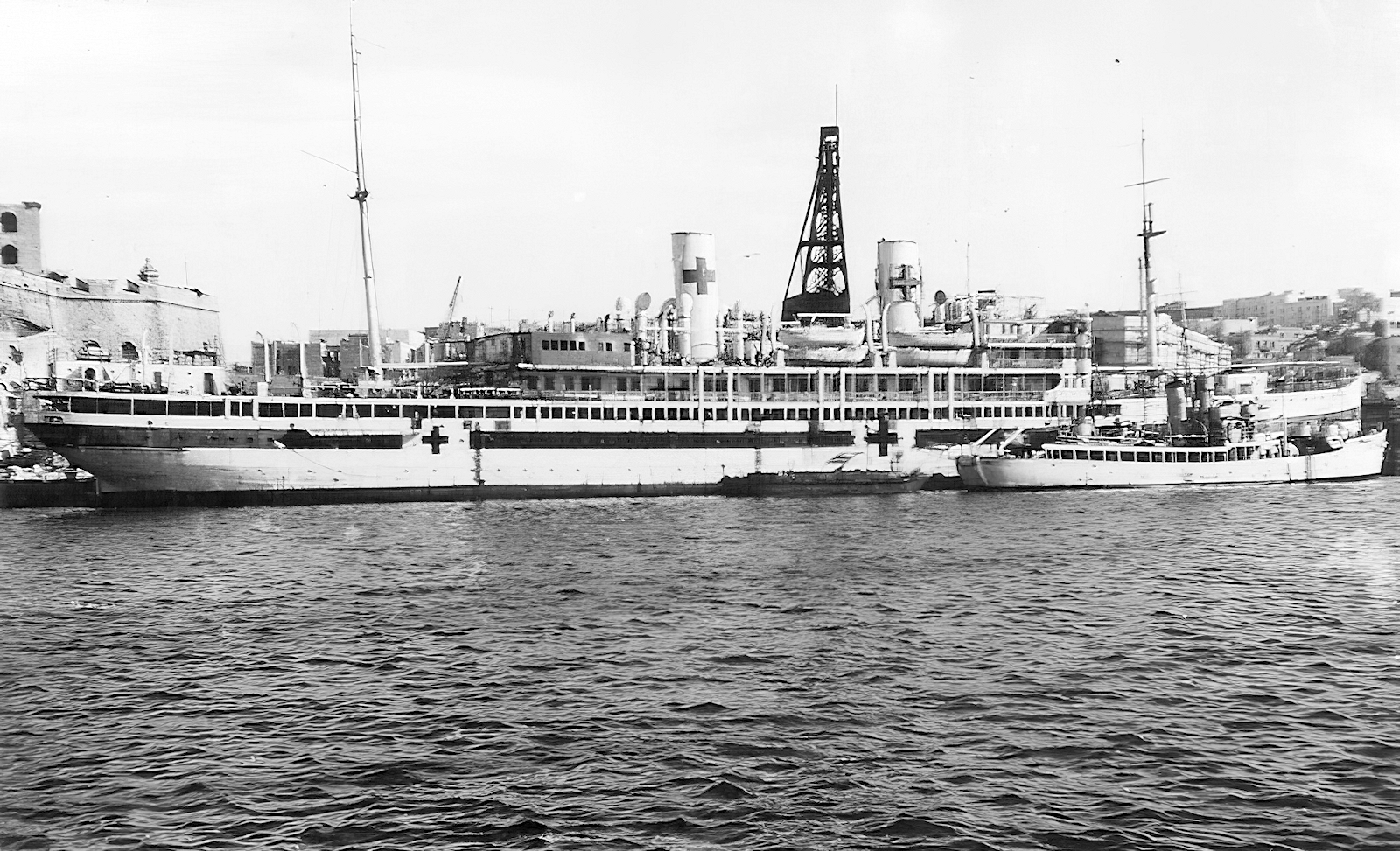
The former EMPIRE CLYDE -Royal Fleet Auxiliary Hospital Ship MAINE at Malta
Last modified: 01 July 2023
Primary information sources
Additional sources:
BT 389/11/147 Ship's record card held by the UK National Archive
(1954) Surgeon Commander J. L. S. COULTER, D.S.C., R.N., ‘THE ROYAL NAVAL MEDICAL SERVICE’ London, Her Majesty's Stationery Office - Volume 1'Administraion'
Hansard 18 October 1950 Hospital Ship "Maine"
Comments (0)